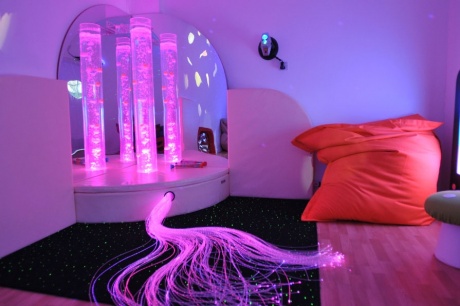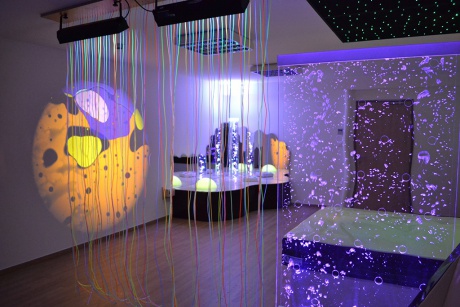Multi - sensory rooms "snoozelen"
Multi - sensory rooms "snoozelen"
Sensory Rooms in Mental Health
Multi - sensory / miracle room furnishing. Sensory Therapy perform.
'' Snoezelen '' is thoughtfully built environment to provide patient - child or adult in the assets and liabilities, and specific sensory stimulation, with the common goal of maintaining or increasing the patient's well-being and functioning.
'' Snoezelen '' is a multisensor or multi-sensory room, decorated in visual, auditory, tactile, olfactory and gustatory sense activation.
'' Snoezelen '' or multisensor space provides both relaxation and peace recovery and new experience cognitive atmosphere and a sense of security and confidence, which is necessary Feelings of emotion and identification.
Rehavita provides professional multisensor room matching.
Rehavita offers multisensor equipment from Barry Emons NL.
Rehavita advise multisensor room projects individually after each use, we recommend you the most suitable solutions to achieve high-quality end result.
Rehavita continues its cooperation with the customer after room multisensor installation. We also offer further cooperation, practical products offered range extension, certified training staff for technical support.
More info ask: info@rehavita.eu
Sensory Room: An Umbrella Term
“Sensory Room” is an umbrella term used to categorize a broad variety of therapeutic spaces specifically designed and utilized to promote self-organization and positive change. There are multiple types of sensory rooms and purposes for use that have been created and implemented in different practice areas to date. When used appropriately, sensory rooms:
-
- Help to create a safe space
-
- Facilitate the therapeutic alliance
-
- Provide opportunities for engagement in prevention and crisis de-escalation strategies, as well as a host of other therapeutic exchanges (to teach skills, offer a variety of therapeutic activities, etc.)
-
- Promote self-care/self-nurturance, resilience & recovery
Generally, to help guide conceptualization, there are a variety of therapeutic spaces that may be categorized under the sensory room umbrella: sensory modulation rooms, sensory integration rooms and snoezelen rooms are examples.
The Sensory Room Umbrella
In mental health settings, there may be one or more sensory rooms created, which typically fall under the sensory modulation room category. For example, on an acute or long-term care unit, there may be converted quiet room spaces that are designed to be more sensory supportive and used primarily for the purposes of crisis de-escalation and/or prevention. However, other kinds of sensory rooms in mental health care also include any additional therapeutic spaces that have been enhanced or developed for sensory supportive, therapeutic purposes. In this way, all of these sensory room spaces are used primarily to promote sensory modulation. Whereas, sensory integration rooms are created and used specifically by occupational therapists who are trained in sensory integration techniques and these spaces contain very specific types of equipment and intervention processes. Snoezelen rooms are generally used with people with moderate to profound cognitive impairment (e.g., people with pervasive developmental disabilities or dementia), and are often used to promote relaxation, social interaction and/or to provide activities affording intense stimulation. In most cases, all but sensory integration rooms are used by inter-disciplinary staff with training or certification specific to the kinds of equipment and approaches offered within the space.
However, it is important to point out that a mixture of sensory modulation and snoezelen approaches may be combined if it is beneficial for the specific consumer population and practice setting. Additionally, sensory integration equipment and techniques may be utilized in either a sensory modulation or snoezelen room by a skilled occupational therapist. Further, therapeutic exchanges in sensory integration rooms may also focus on sensory modulation. Therefore, this sensory room categorization is meant to be flexible and is to be used only as a guide.
The enhancement of the physical environment, including the use of sensory rooms, affords a more nurturing and recovery-oriented therapeutic environment. Skilled nursing facilities, day treatment centers, schools, long-term care facilities, respite care homes, hospitals, emergency rooms and hospice care settings are just some of the organizations utilizing sensory rooms.
Sensory Rooms in Mental Health?
The idea to expand the use of sensory rooms to acute inpatient mental health care settings with varied populations is a more recent application, incorporating a variety of sensory modulation approaches and modalities. Hence, the use of sensory rooms in mental health settings often falls under the sensory modulation category. An essential part of this mission is to maintain an emphasis on engaging in meaningful therapeutic activities and in recognizing the inter-relatedness and importance of the therapeutic use of self and physical environment. Offering humane and self-nurturing choices for prevention and crisis de-escalation is essential and afforded in an organized and safe manner through therapeutic exchanges in sensory modulation rooms.
Two recent articles demonstrate the purpose of the incorporation of the use of sensory rooms and additional sensory-related approaches into mental health inpatient practice (Champagne & Stromberg, 2004) and provide a guideline to assist in the evolutionary process (Champagne, 2006). Champagne’s book, available through this website’s product page, is another valuable resource available to assist in the process of developing and integrating sensory rooms and other sensory approaches into mental health care practice settings.
There is limited literature and research available regarding the use of sensory rooms in acute care inpatient mental health settings with pediatric, adolescent, and adult populations. However, the following is an article regarding a quality improvement study conducted on the use of the sensory room at Cooley-Dickinson Hospital's acute care psychiatric unit:
The Effects of the Use of the Sensory Room in Psychiatry
A Quality Improvement Study
By: Tina Champagne, M.Ed. OTR/L & Edward Sayer, Psy.D
This quality improvement study was replicated on this unit in 2004 with astonishingly similar results. Among the patients who utilized the sensory room during group or individual sessions, most report having had a positive response and a decrease in perceptions of distress.
In 2006, Champagne published an article on creating sensory rooms for the American Occupational Therapy Association's Mental Health Special Interest Section. The reference information for this article is:
Champagne, T. (2006). Creating sensory rooms: Environmental enhancements for acute inpatient mental health settings. Mental Health Special Interest Section Quarterly, 29(4), 1-4.
The sensory room's purpose also corresponds with the purpose of the Safety Tool developed and promoted by the Department of Mental Health in the state of Massachusetts. The Safety Tool was developed in an attempt to facilitate trauma-informed care and to help to reduce the occurrences of seclusion and restraint by learning about each person's early warning signs, triggers and what helps each individual early in the therapeutic process. The safety tool is typically administered by nursing staff during the initial assessment. The information obtained through the use of the safety tool has been helpful to occupational therapists during the information-gathering period prior to initial therapeutic exchanges with each consumer.
Taking A Leadership Role
Occupational therapists are taking a leadership role in the planning and implementation of the use of sensory approaches across mental healthcare settings, including the focus on environmental modifications and enhancements, such as sensory rooms. As in other areas of practice, the education and knowledge base of occupational therapists helps to justify the unique role of the OT as the qualified professional to supervise the development and implementation of the "sensory room" and other sensory approaches. Currently, occupational therapists are also collaborating with administrators and other disciplines to ensure staff trainings and competencies are developed, implemented and maintained. Program evaluation is another important component of any new program initiative, and occupational therapists are also playing a key role in this area as well.
The first adult acute inpatient mental healthcare setting to develop a sensory room was Berkshire Medical Center (BMC) in Pittsfield, MA. With the help of consumers and staff, Tina Champagne, OTR/L initiated and coordinated the development and implementation of this sensory room for adult acute care psychiatry after receiving administrative approval in 1999. She used interviews and questionnaires with staff and consumers to collect the following types of information: what people wanted the purpose of the room to be, ideas for ways to utilize the space, ideas for what to have available in the room, how people wanted the space to be decorated, etc. At this time, there are many such rooms in existence within acute care mental health settings with varied themes and purposes.
The development and implementation of sensory rooms and sensory enhancements across settings is a process that typically evolves over time. This affords the ability to get staff and consumer involvement and assistance throughout the entire process. Thus, it is possible to start a room on a very low budget and to slowly develop the space. One of the differences between the types of sensory rooms Champagne promotes and the more traditional "Snoezelen" style rooms, is in the shift from spaces filled with expensive technical equipment, to a more normalizing and replicable environment. Safety considerations within locked acute care settings as well as the need to offer options that the consumers can replicate outside of the hospital setting are some of the other reasons behind the differences in both approach and décor. Snoezelen rooms and the kinds of sensory rooms Champagne promotes are also different from the sensory integration style treatment rooms used specifically by occupational therapists that are trained, certified and competent to use such specialized equipment and techniques. Hence, it is necessary to understand these distinctions due to the very different purposes of each of these sensory-related therapeutic environments.


